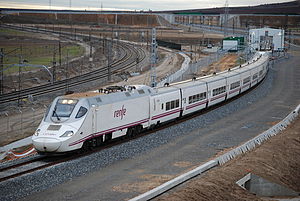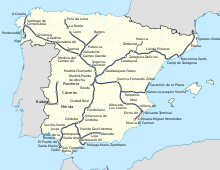
Rail transport in Spain operates on four rail gauges and services are operated by a variety of private and public operators. Total railway length in 2020 was 15,489 km. The Spanish high-speed rail network is the longest HSR network in Europe with 3,966 km and the second longest in the world, after China's.

Talgo is a Spanish manufacturer of intercity, standard, and high-speed passenger trains. Talgo is an abbreviation of Tren Articulado Ligero Goicoechea Oriol.

Alta Velocidad Española (AVE) is a high-speed rail service operated by Renfe, the Spanish State railway company.

High-speed railways in Spain have been in operation since 1992 when the first line was opened connecting the cities of Madrid, Córdoba and Seville. Unlike the rest of the Iberian broad gauge network, the Spanish High-speed network mainly uses standard gauge. This permits direct connections to outside Spain through the link to the French network at the Perthus Tunnel. High-speed trains run on a network of high-speed rail track owned and managed by ADIF, where the dominant service is AVE while other high speed services such as Avant, Alvia, Avlo, Euromed, Ouigo España and Iryo, as well as mid-speed (Altaria) services also operate.
Euromed is a high-speed rail service operated by Renfe along the Spanish Mediterranean coast.

The Renfe Class 100 is a high-speed train used for AVE services by the Renfe Operadora, in Spain. It was the first high-speed train put into service in Spain, in 1992.

The Renfe Class 102 or S-102 is a push-pull high-speed train used for the AVE service and operated in Spain by the state-run railway company Renfe, and based on Bombardier Transportation's power car technology. Outside AVE service, Talgo markets this train as the Talgo 350.
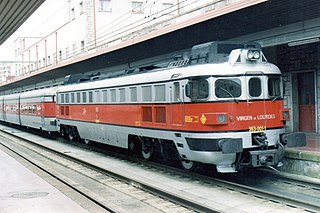
The Renfe Class 353, formerly known as the T-3000 are a class of diesel-hydraulic locomotives built by Krauss-Maffei for express trains in Spain.

The Renfe Class 352 was a class of twin engined four axle diesel-hydraulic locomotives built by Krauss-Maffei, designed solely for passenger traffic; in particular they were responsible for towing Andalusian Talgo III trains. The class were very successful, heralding a new era of passenger trains in Spain. They were delivered in 1964 and 1965, and were fully withdrawn during the 1990s.

The Renfe Class 354 was a series of eight diesel hydraulic locomotives manufactured by Krauss-Maffei in Germany specifically to pull Talgo pendular coaches which were introduced shortly before the acquisition of these machines.
Alvia is a high-speed train service in Spain offered by Renfe Operadora on long-distance routes with a top speed of 250 km/h (160 mph). The trains have the ability to use both Iberian gauge and standard gauge, which allows them to travel on the recently constructed high-speed lines for part of the journey before switching to the "classic" Iberian gauge network to complete it. Trains that run exclusively on high-speed tracks are branded AVE or Avant.
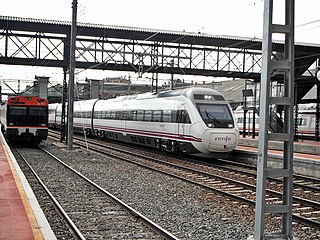
The Renfe Class 120 are electric multiple units used on Alvia high-speed rail services in Spain.

The Madrid–Asturias high-speed rail line connects the city of Madrid with the autonomous community of Asturias and was inaugurated on 29 November 2023. The line is built to standard gauge and gauge changers are provided at strategic points to allow interchange with older Spanish railways which were built to Iberian gauge.

Talgo Avril is a push-pull high-speed train made by Talgo. It stands for "Alta Velocidad Rueda Independiente Ligero".

El tren Estrella was a conventional overnight railway service provided in Spain by the national rail network operator RENFE until April 2015. Services left most major Spanish cities in the evening and usually arrived at their destination the following morning.
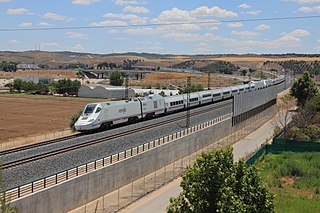
The Renfe Class 730 or S-730 is a push-pull high-speed dual-gauge, dual-voltage and hybrid trainset consisting of 9 Talgo VII tilting coaches, two intermediate diesel-generator cars and two head electric power cars, used on Alvia services. The class have been nicknamed patitos, due to the shape of the train nose. They are a variant of RENFE Class 130 modified to be able to run on both electric and diesel power, in order to extend higher-quality services to parts of Spain not on the electrified network.

The Madrid–Galicia high-speed rail line is a high-speed railway line in Spain that links the city of Madrid with the region of Galicia via the cities of Olmedo, Zamora, Ourense and Santiago de Compostela. The line also connects the Atlantic Axis high-speed rail line to the rest of the Spanish AVE high-speed network. The Madrid–Galicia high-speed rail line is constructed as double electrified line and is designed for trains running at speeds up to 350 kilometres per hour (220 mph).

An electro-diesel multiple unit (EDMU) or bi-mode multiple unit (BMU) is a form of a multiple unit train that can be powered either by electric power picked up from the overhead lines or third rail or by using an onboard diesel engine, driving an electric generator, which produces alternating current (AC) or direct current (DC) electric power.

Avlo is a low-cost high-speed rail service operated by Spanish national rail company Renfe, offering services connecting major Spanish cities such as Madrid, Zaragoza, Barcelona, Valencia, Alicante and others on specific high-speed lines.
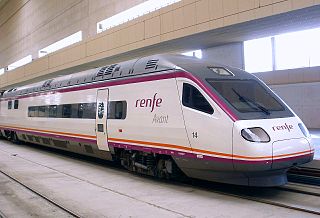
Avant is a high-speed, medium-distance passenger transport rail service, operated in Spain by the Spanish public company Renfe. Avant services circulate at a maximum speed of 250 km/h (160 mph), compared to the 300 km/h (190 mph) maximum speed of the AVE service. Their routes usually cover different provinces within the same autonomous community or between neighboring ones. Regional services at conventional speed are called Renfe Media Distancia.
